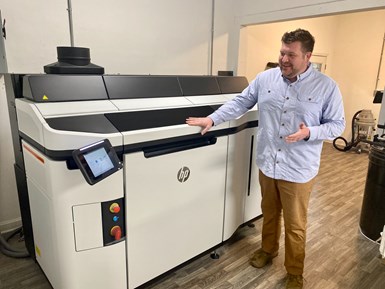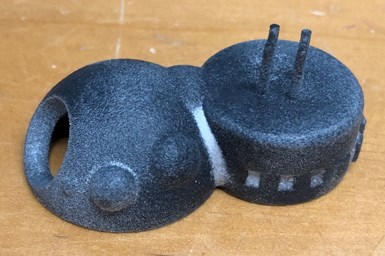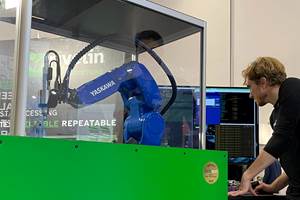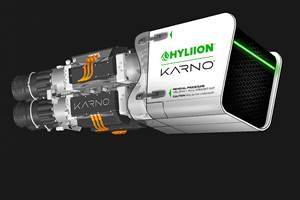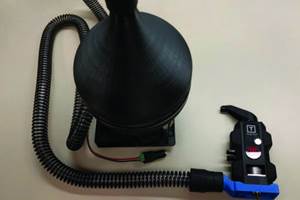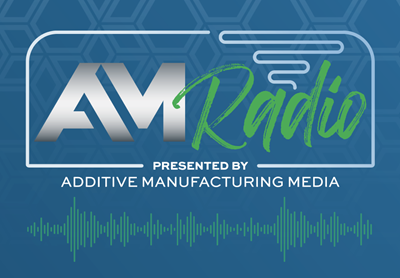3D printing is making manufacturing more accessible, even to those without a manufacturing background. That's the case for JP Kinerk, founder of additive manufacturing (AM) startup company, OMG Additive. Since launching his AM business as an entrepreneur with no previous engineering training, rather a lifelong passion for cars and hands-on creation, Kinerk is uncovering tips and tricks of the trade in the AM space.
Kinerk stands next to part of his HP Multi Jet Fusion (MJF) 5200 printer series. Photo credit: OMG Additive
Recently established as of 2022, OMG Additive aims to function as an “onshore” manufacturing company, servicing industries in need of 3D printed parts. Located in Cincinnati, Ohio, Kinerk’s hope is to first plant roots locally, then dive into production printing for industries across the board, including sustainment, manufacturing, medical, custom prototyping and tooling, as well as OEM automotive.
The 3D printed pieces are motorsport front splitter prototype parts, coated in-house using OMG Additive’s Cerakote service. Photo credit: OMG Additive
At present, Kinerk is printing with one HP Multi Jet Fusion (MJF) 5200 printer series, as he continues to learn the ins and outs of additive. Kinerk says in addition to printing parts, OMG Additive offers an in-house Cerakote service. He plans to add more pre- and post-printing services such as 3D Creaform scanning and other finishing options for customers as his business progresses.
OMG Additive Roots
Currently, OMG Additive is a one-man show. “There’s a substantial learning curve in establishing an AM startup,” reveals Kinerk, who manages, markets and runs this business on top of his day job (managing for a horticulture firm).
Around three years ago, Kinerk says he became fascinated with 3D printing and additive capabilities. Kinerk represents a distinct trend in the additive space: business owners coming from little to no experience in AM. Despite this, from an early age, Kinerk loved to work with his hands, building and creating — skills that since have proven useful during his startup journey.
Flash forward to present day, Kinerk is in the process of establishing OMG Additive locally, then aims to offer services on a more global scale.
6 Steps Imperative to Building an AM Startup
Although Kinerk is less than a year in business at OMG Additive, the lessons he’s learned thus far in getting this startup moving and off the ground are valuable for any would-be additive founders:
1. Do the Homework
Kinerk says he did an extensive amount of preliminary research and learning before taking any concrete steps in establishing his AM business. “This resulted in a lot of trial and error and independent study, but learning the basics is key,” he adds. Researching desired markets, ensuring optimal funding, and nailing down which products and services to offer were all important steps of the process. Much of Kinerk’s market research as to the viability of additive came from his enthusiasm as a maker.
As far as funding goes, he relied on his machinery partners at Hawk Ridge Systems to present options for capital that made sense for him. “I checked this against other capital funding, doing some basic research online and quickly found it was competitive,” he says. For other entrepreneurs, Kinerk suggests that “A capital group specializing in this type of business funding is your best bet. It reduces the obstacles you might come across in getting a traditional business loan, and you have a better chance of working a deal that protects you as well as the lender.”
2. Be an Informed Buyer
Kinerk says that while vast buying possibilities can be daunting, finding the right company to purchase from and knowing the time frame of the buying cycle can make it easier. As mentioned above, Kinerk worked with Hawk Ridge Systems in finding optimal machinery for a fair cost. Originally, he toyed with the idea of a metal printer, but quickly realized the benefits MJF offered for a more user-friendly approach. “The machine needed to be an affordable yet comfortable fit for me,” he says.
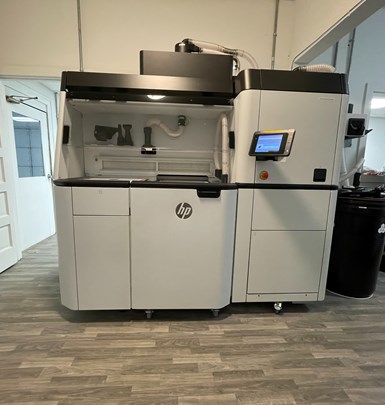
The HP Multi Jet Fusion 5200 printer series requires ample space and energy alike.
Being a careful shopper also applies for the auxiliary equipment needed in addition to the printer. Kinerk owns a bead blaster for postprocessing and finishing purposes, along with a used air pressure system in remarkably good condition (being that it is from the 1920s) to power the bead blaster.
The supplementary equipment is an important consideration in terms of cost and functionality. Kinerk proved thoughtful in his partnering with Hawk Ridge Systems and resourceful in his accumulation of equipment. According to him, finding the right partnership directly affects the education portion of learning printer technology when it comes to set up and use. This is often followed by a continuous trial-and-error period for learning to operate the machinery of choice.
3. Network
This proved hugely beneficial to Kinerk during his early brainstorming days. “Networking with a couple of startups that took a similar path to mine was critical, particularly in my decision to choose a machine,” he says. Kinerk searched for these connections by again utilizing Hawk Ridge Systems. “Essentially they were references, but tailored to what I was attempting to do,” adds Kinerk. Since forging these connections, Kinerk has stayed in touch with Cody Laursen of Streamline 3D in Fresno, California, who had a similar startup experience. Laursen, like Kinerk, began with one machine. “He gave me some great tips for starting out, plus some encouragement to push through the sleepless nights,” recalls Kinerk.
“Learning from those who already have roots in the 3D printing landscape offers not only a wealth of knowledge, but new opportunities to connect with others in the industry,” says Kinerk.
4. Choose the Right Space
Finding an optimal space to foster business is important when establishing an AM startup. Kinerk names the following criteria as crucial to his own journey: Securing a space from a communicative and dependable property owner; access to powerful and consistent electricity; a space substantial in size (to accommodate printers, supplementary equipment and for the possibility of expansion), and of course, an affordable price.
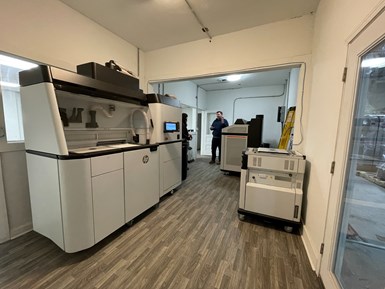
The two images offer a glimpse into the main OMG Additive workspace as well as the garage (which Kinerk rents out to other small businesses in the area).
Photo credit: OMG Additive
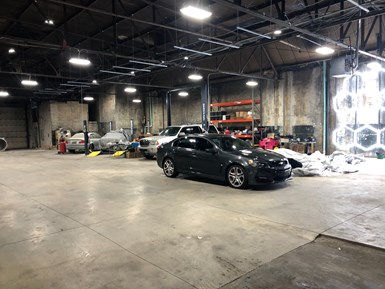
The one most taken for granted? Power. “At this moment, there are two options for power that I’m aware of for a machine like mine: 208-volt three-phase and 380-480-volt three-phase,” Kinerk says. “If you run 208-volt you will need to run 80 amps to the printer; with 380-480-volt you'll be running 48 amps. I went with the 208-volt three-phase simply because of the cost of implementing 380-480-volt. If expanding into running multiple machines 24 hours a day, looking into 380-480-volt service would make sense as the fewer amps you draw, the less your monthly energy bill will be. For most folks starting out however, 208-volt will be most accessible both in practical and financial terms. It can be quite the challenge to get new high voltage service to a new or existing building. Take it from someone who knows.”
With energy being as pricey as it is, one way to make renting a facility more affordable is to sublet unused space out to small businesses and other tenants. Kinerk rents his (purposefully) large space to a few different businesses, which often aids in covering his monthly rent.
5. Be Prepared for Trial and Error
Securing the right fit in terms of 3D printing technology and application can be tricky for novices of AM. In OMG Additive’s case, Kinerk decided to go with HP’s MJF printer series for its relative operator ease. Kinerk shares he is still becoming acquainted with his 3D printer of choice and its capabilities, honing new skills after every build.
Kinerk’s most recent discovery stems from experimenting with part orientation during individual builds. (While software tools exist to help automate orientation and nesting, they are expensive enough to be out of reach for some startups, including OMG Additive.) Learning how many pieces he can fit and furthermore most efficiently and at what angle has proven an intriguing challenge for him.
The printed part depicts a thermal bleed, one build challenge Kinerk is learning to overcome in his additive journey. This is a small test part, and what looks to be unfused powder (the whiter strip in the middle) is actually hardened material caused by thermal bleed (where the irradiance or heat is too high in the machine). Photo credit: OMG Additive
“Trial and error is just an innate part of the learning process. Every type of manufacturing I'm aware of has limitations, and (for now) additive is no exception. That said, most of the challenges one will face in MJF are related to the orientation of the parts in the build manager software and the management of heat during printing,” Kinerk says.
He shares that the nesting of parts in the Multi Jet Fusion environment is vital because of the way the fusing agents are laid onto the powder. The angle at which certain features (curves, fine details, etc.) are oriented can dictate the quality of the part. “While there is quite a bit of forgiveness in that equation, trial and error is a must-have portion of the process,” he says.
“For me, this was paying close attention to the best practices in the HP training documents. They provide great onboarding and I'd highly encourage anyone in shoes like mine to add and embrace the advanced training option for purchase,” says Kinerk.
6. Consider Capacity-Fillers
Currently, the company’s main customer is a local tech startup (discovered, as it turns out, through networking) but one of Kinerk long-term goals for OMG Additive is to establish a diverse, local client base. In the meantime? Kinerk shares that turning to online AM marketplaces assists in generating initial income and keeps the printers printing during lulls between building up clientele. One resource he mentions is Hubs, a digital marketplace where providers (like Kinerk) can join, and clients can upload designs as needed. Hubs then generates quotes and directs the work to the manufacturer best suited to complete the available job. For a startup business like OMG Additive, this saves time and provides quick jobs to combat downtime as well as a continued learning opportunity to use machinery. The downside? There is a lack of client-facing interaction, as services like Hubs function more so as one-time print jobs. For Kinerk, this is valuable at present as he continues to build his own local clientele.
Kinerk shares one of his most gratifying takeaways is quite simple: pay it forward. Thankful for the support he’s garnered via networking and the many previously mentioned resources available to him, Kinerk remains enthusiastic to share his experience with others newly entering the manufacturing space by way of AM.
Related Content
The Robot Craftsman: Force Sensing and Vision Help Realize Automated AM Postprocessing (Includes Video)
Automated production via additive manufacturing will need automated postprocessing. This UK startup is equipping robots with the capabilities needed for critical, fine-detail finishing of metal 3D printed parts.
Read MoreGE Sells Generator Technology for Stake in EV Startup
The company says the Karno generator is expected to be 20%+ more efficient than today’s leading generators — achieved by 3D printing of thermal components and innovative fuel-to-electricity conversion.
Read MoreNIOSH Publishes 3D Printing Safety Guide for Nonindustrial Settings
NIOSH has published a 3D printing safety guide for small businesses and other additive manufacturing users such as makerspace users, schools, libraries and small businesses.
Read MoreThe Cold Spray Solution to the Casting, Forging Supply Chains
Startup HAMR Industries performs additive manufacturing work at Neighborhood 91 that provides an alternative to traditional casting and forging. Success so far has led to redefining the limits of its additive equipment.
Read MoreRead Next
How to Implement Additive Manufacturing Across a Global Company: 5 Lessons
With more than 100 facilities and about 200,000 employees worldwide, Flex has a steep challenge in bringing 3D printing into its operations. Five things the company is learning.
Read MoreThe New Misperceptions Of AM: AM Radio #35
Tim Simpson and Peter Zelinski discuss a way additive manufacturing has advanced: The misperceptions have shifted. Knowledge of AM among manufacturers is more sophisticated now. The concerns that inform the perceptions of newcomers have therefore changed.
Read MoreDoes 3D Printing Drive Startups, or Vice-Versa? AM Radio #1
What is it about 3D printing that makes it such a common choice for startup companies? Are these businesses driving additive manufacturing forward, or are they being driven? Peter Zelinski, Stephanie Hendrixson and Julia Hider discuss.
Read More





